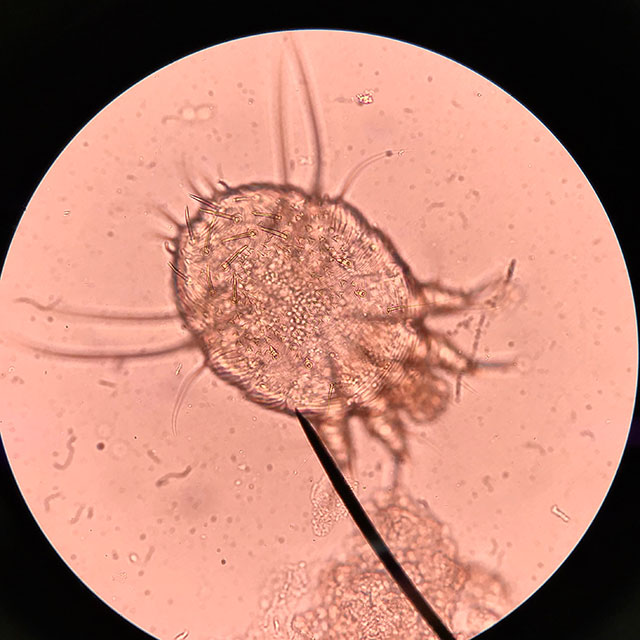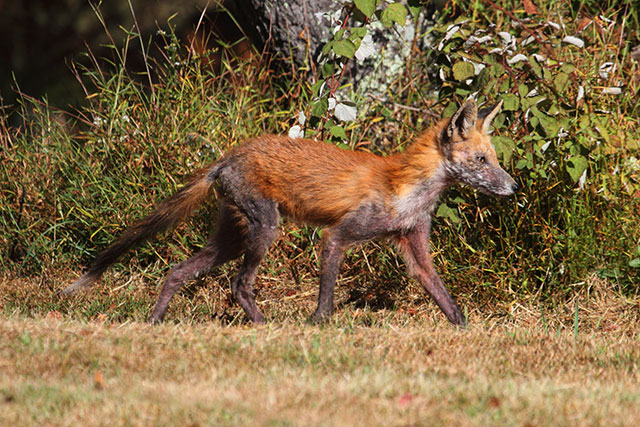Sarcoptic mange
Learn about this naturally occurring and common disease in Ontario wildlife.
About mange
Mange is a highly contagious skin disease caused by parasitic mites that can infect both domestic and wild mammals.
Mange does not usually have a significant effect on stable wildlife populations and outbreaks generally resolve on their own over time. The ministry does not actively capture and treat wildlife infected with mange.
When populations of susceptible animals are high, mange can spread rapidly. While infected animals may be noticeable, they should recover on their own without treatment if they are otherwise healthy.
Different types of mange
There are several different types of mange, each caused by a different mite species. Sarcoptic mange, caused by the Sarcoptes scabiei mite, is one of the most common types of mange. With sarcoptic mange, mites infest the skin of many mammal species, including:
- red foxes
- coyotes
- wolves
- raccoons
- bears
- domestic dogs
- humans
How mites cause mange

The mites burrow through the outer layer of the animal’s skin, where they form tunnels and lay eggs. Once the eggs hatch, the newly hatched mites spend their life on a single host animal.
Infected wildlife are commonly seen by humans in early winter once leaf cover is reduced and when wild animals experience increased stress from colder weather and may take increased risks to get food from human sources.
Signs of mange infection
Burrowing mites can cause extreme skin irritation, which causes inflammation, itching, skin crusts and hair loss.

Severe infections can result in:
- extensive hair loss
- scabbing
- thickened skin
- thick, grey and foul-smelling crusts caused by secondary bacterial infections
- weight loss
Extreme discomfort and hair loss caused by mange can lead to exposure to the elements, starvation and death.
How mange spreads
Mange is spread by:
- direct contact with an infected animal
- contact with a contaminated environment, such as animal den sites and bedding areas
Mange and other wildlife diseases can spread more easily in dense populations. Feeding or baiting of wildlife can cause mange to spread more rapidly because it encourages wild animals to gather together.
Infections in humans or pets
Some types of sarcoptic mange can infect humans and our pets including dogs and cats.
Prevent mange
To prevent infection with mange:
- keep a safe distance from wild animals and potentially contaminated sites such as denning sites
- wear disposable gloves, change your clothing and wash your hands well with soap when handling potentially infected materials (for example, removing a nest from a shed or moving a woodpile)
If you suspect you may have contracted mange, consult a medical doctor. Humans infected with mange most often contract it from other humans.
If you suspect your pet has mange, contact your veterinarian.
Treatment of free-ranging wildlife
Mange has no long-term effect on stable wildlife populations. For some isolated populations of endangered species, capture and treatment of animals may be warranted.
Under the Veterinarians Act, 1990, you can not bait food with drugs to treat mange and leave them out with the intention of helping free-ranging wildlife infected with mange.
For the safety of people, pets and wildlife, do not place any prescription drug in an uncontrolled setting (for example, putting medication in a hot dog or meatball), this activity:
- is usually ineffective and can be dangerous because treatment must be specific and appropriate to the type of mange as well as the body weight and health condition of the infected animal
- is illegal because the drugs are controlled substances, and treatment must be done under the direct supervision of a licensed veterinarian
- could be dangerous to other animals who may eat the drug-baited food, for example a pet dog, as they are eating an unknown quantity of a controlled drug that was not prescribed to them
- may spread mange since feeding wildlife can encourage gathering of infected animals
- may incorrectly appear effective because most wild animals will resolve the mange on their own
What to do if an animal has mange
If you suspect a wild animal has mange, keep your distance from the animal and leave it alone.
If you believe an animal is in distress, consider reporting it to your local animal services or an authorized wildlife rehabilitator.
If the animal poses an immediate threat to public safety, such as showing threatening or aggressive behaviour, call your local police department.